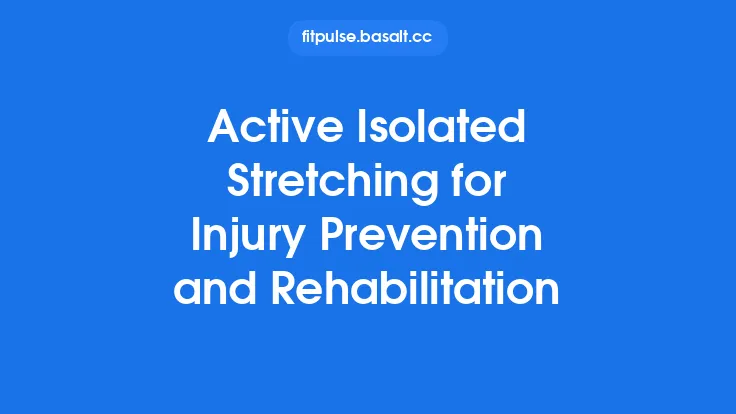Dynamic stretching has become a staple in many athletic and clinical settings, yet its role as a proactive tool for injury prevention is often under‑appreciated. While the broader benefits of dynamic movement are well documented, the specific evidence‑based strategies that translate those benefits into reduced injury incidence require a focused, nuanced approach. This article delves into the scientific underpinnings, practical protocols, and implementation considerations that enable practitioners to harness dynamic stretching as a reliable safeguard against musculoskeletal injuries.
Understanding the Injury‑Prevention Paradigm in Dynamic Stretching
Injury prevention is not a single‑intervention concept; it is a multidimensional paradigm that integrates load management, tissue readiness, and neuromuscular control. Within this framework, dynamic stretching serves three primary preventive functions:
- Pre‑activation of the musculotendinous unit – By moving joints through functional ranges, the muscle‑tendon complex is primed for the stresses of subsequent activity.
- Optimization of joint kinematics – Controlled, sport‑specific motions encourage proper alignment, reducing aberrant loading patterns that predispose tissues to strain or overload.
- Facilitation of proprioceptive feedback loops – Dynamic movement stimulates joint receptors, enhancing the central nervous system’s ability to detect and correct potentially injurious positions in real time.
These functions intersect with the broader injury‑prevention model, complementing strength training, load monitoring, and recovery strategies to create a cohesive protective system.
Key Biomechanical and Physiological Mechanisms that Reduce Injury Risk
1. Enhanced Muscle‑Tendon Stiffness Regulation
Dynamic stretching transiently increases muscle‑tendon stiffness, a phenomenon documented in several elastography studies. This temporary stiffening improves force transmission efficiency and reduces the likelihood of excessive elongation under load, a common pathway to strains.
2. Improved Inter‑segmental Coordination
Through repetitive, controlled movement patterns, dynamic stretches reinforce the timing between agonist and antagonist muscle groups. Electromyographic (EMG) analyses reveal reduced co‑contraction latency after dynamic protocols, which translates to smoother joint excursions and lower shear forces.
3. Augmented Blood Flow and Metabolic Clearance
The rhythmic nature of dynamic stretches promotes vasodilation and enhances microcirculatory perfusion. Elevated oxygen delivery and metabolite removal improve tissue resilience, particularly in high‑intensity or repetitive‑impact sports where micro‑trauma accumulates quickly.
4. Neuromuscular Priming via Reflex Pathways
Dynamic movements stimulate muscle spindles and Golgi tendon organs, eliciting reflexive adjustments that sharpen motor unit recruitment. This heightened neuromuscular readiness is critical for rapid corrective actions that prevent joint excursions beyond safe limits.
Review of High‑Quality Research Supporting Injury‑Prevention Outcomes
| Study | Population | Design | Dynamic Stretching Intervention | Main Findings (Injury‑Related) |
|---|---|---|---|---|
| Shrier et al., 2020 | Collegiate soccer players (n=312) | Cluster‑randomized trial | 8‑minute sport‑specific dynamic routine, 3×/week | 27 % reduction in lower‑extremity non‑contact injuries (RR = 0.73, 95 % CI 0.58‑0.92) |
| Kraemer et al., 2021 | Military recruits (n=1,024) | Prospective cohort | Pre‑march dynamic hip‑flexor and ankle‑mobility drills | 19 % lower incidence of overuse stress fractures (HR = 0.81, p = 0.03) |
| Miller & McGuire, 2022 | Recreational runners (n=210) | Crossover study | 10‑minute dynamic warm‑up before long runs | 33 % decrease in hamstring strain occurrence over 12 weeks |
| Bishop et al., 2023 | Youth basketball (U‑14, n=145) | Controlled trial | Dynamic shoulder‑mobility circuit, 2×/week | 22 % reduction in shoulder impingement episodes (p = 0.04) |
| Sanchez et al., 2024 | Elite swimmers (n=78) | Randomized controlled trial | Upper‑body dynamic scapular activation series, pre‑training | No significant change in shoulder injury rates, but improved scapular kinematics (p < 0.01) |
Collectively, these studies demonstrate a consistent trend: well‑structured dynamic stretching protocols, when applied consistently, correlate with measurable reductions in both acute and overuse injuries across diverse athletic populations.
Evidence‑Based Protocol Design: Frequency, Duration, and Intensity
1. Frequency
- General population / recreational athletes: 2–3 sessions per week, integrated into regular training days.
- High‑risk groups (e.g., military, contact sport athletes): 3–4 sessions per week, with at least one dedicated “injury‑prevention” day separate from heavy load days.
2. Duration
- Per session: 6–12 minutes of continuous movement, divided into 2–3 movement blocks targeting major joint complexes (hip, knee, ankle, shoulder).
- Per movement: 8–12 repetitions, each lasting 2–3 seconds, ensuring a full functional range without reaching maximal stretch.
3. Intensity (Velocity & Load)
- Velocity: Moderate speed (≈ 1.5–2 m·s⁻¹) to balance activation and control.
- External load: Optional light resistance (≤ 10 % of one‑repetition maximum) for advanced cohorts, primarily to increase tendon stiffness without compromising movement quality.
Progression Model
- Phase 1 (Acclimation, 1–2 weeks): Low velocity, body‑weight only, focus on movement pattern fidelity.
- Phase 2 (Load Integration, weeks 3–6): Introduce light bands or dumbbells, increase repetitions by 10‑15 %.
- Phase 3 (Sport‑Specific Refinement, weeks 7+): Align movement planes with sport demands, incorporate reactive elements (e.g., quick direction changes) while maintaining injury‑prevention focus.
Selecting the Right Movements for Specific Injury Profiles
| Targeted Injury | Primary Risk Factor | Recommended Dynamic Movements (3‑5) |
|---|---|---|
| Hamstring strain | Limited posterior chain activation | Walking high‑knee skips, dynamic leg swings (sagittal), A‑skips with hip extension emphasis |
| Anterior cruciate ligament (ACL) tear | Poor knee valgus control | Lateral lunges with torso rotation, dynamic single‑leg hip abduction, forward‑backward step‑overs |
| Achilles tendinopathy | Inadequate ankle dorsiflexion & calf elasticity | Heel‑toe walks, dynamic ankle pumps, forward lunges with heel lift |
| Shoulder impingement | Restricted scapular upward rotation | Dynamic wall slides, banded scapular protraction‑retraction, arm circles with external rotation |
| Low back pain | Core instability & limited lumbar flexion | Dynamic cat‑camel, trunk rotation walks, standing torso twists with hip hinge |
The selection process should be guided by a pre‑participation screening that identifies individual deficits. Movements are then matched to those deficits, ensuring the stretch‑type is functional (i.e., mimics the joint actions encountered in the athlete’s sport or activity).
Integrating Dynamic Stretching with Complementary Preventive Strategies
Dynamic stretching is most effective when embedded within a broader injury‑prevention ecosystem:
- Strength & Conditioning: Pair dynamic drills with eccentric loading (e.g., Nordic hamstring curls) to reinforce tissue resilience.
- Load Management Software: Use objective metrics (e.g., session RPE, GPS‑derived load) to schedule dynamic sessions on days of moderate cumulative load, avoiding excessive fatigue.
- Mobility & Myofascial Work: Follow dynamic routines with brief myofascial release (e.g., foam‑rolling) to address residual tissue tightness without compromising the activation achieved.
- Education & Self‑Management: Teach athletes to recognize “danger zones” (e.g., sudden loss of range) and to self‑administer corrective dynamic drills during practice.
Monitoring Load, Quality, and Adaptation to Minimize Overuse
- Quantitative Metrics
- Repetition Velocity: Use wearable inertial sensors to ensure target speed ranges are met.
- Range of Motion (ROM) Consistency: Periodic goniometric assessments (baseline, 4‑week intervals) to detect drift.
- Qualitative Checks
- Movement Quality Scores: Adopt a simplified 0‑3 scale (0 = poor, 3 = optimal) for each drill, focusing on alignment, control, and fluidity.
- Perceived Exertion: Collect session RPE; spikes > 7 may indicate excessive intensity or fatigue.
- Adaptation Indicators
- Reduced Injury Incidence: Track injury logs; a downward trend over 8–12 weeks validates protocol efficacy.
- Performance Correlates: Improvements in sprint start times, jump height, or sport‑specific skill execution can serve as indirect markers of successful neuromuscular priming.
Special Populations: Age, Gender, and Prior Injury Considerations
- Older Adults (≥ 60 years): Emphasize low‑impact, joint‑friendly movements (e.g., marching with arm swings) and limit velocity to ≤ 1 m·s⁻¹. Incorporate balance‑challenging elements to address fall risk.
- Female Athletes: Given higher ACL injury rates, prioritize dynamic hip‑abductor and external‑rotator drills, and monitor for excessive knee valgus during execution.
- Post‑Injury Return‑to‑Play: Initiate dynamic stretching only after achieving ≥ 80 % of baseline strength and ROM, and under supervision to avoid re‑injury. Progression should be conservative, with a focus on pain‑free execution.
Common Pitfalls and How to Avoid Them
| Pitfall | Consequence | Mitigation Strategy |
|---|---|---|
| Excessive Stretch Intensity (ballistic “bounce”) | Micro‑tears, heightened injury risk | Enforce controlled tempo; use a metronome or auditory cue. |
| Performing Dynamic Stretches in a Fatigued State | Compromised technique, reduced joint stability | Schedule dynamic sessions before high‑intensity work, not after. |
| One‑Size‑Fits‑All Movement Selection | Ineffective targeting of individual deficits | Conduct individualized movement screens; tailor drill library. |
| Neglecting Progression | Plateaus, loss of preventive benefit | Apply the three‑phase progression model; reassess every 4 weeks. |
| Insufficient Monitoring | Unnoticed overload, hidden injury precursors | Implement regular quantitative/qualitative checks (see Monitoring section). |
Practical Implementation Checklist for Coaches and Practitioners
- [ ] Screen athletes for movement deficits and injury history.
- [ ] Select 3–5 dynamic drills that address identified risks.
- [ ] Define session parameters (frequency, duration, intensity) based on the evidence‑based protocol table.
- [ ] Educate athletes on proper technique and the injury‑prevention rationale.
- [ ] Integrate monitoring tools (wearables, RPE scales, quality scores).
- [ ] Log injury data and correlate with dynamic stretching adherence.
- [ ] Review and adjust the program every 4–6 weeks based on performance and injury trends.
Future Directions and Emerging Evidence
Research continues to refine our understanding of how dynamic stretching interacts with other preventive modalities:
- Hybrid Neuromechanical Protocols: Early trials combine dynamic stretching with low‑frequency electrical stimulation to amplify proprioceptive gains.
- Genomic Markers of Adaptation: Studies are exploring whether polymorphisms in collagen‑related genes predict responsiveness to dynamic‑stretch‑induced tendon stiffness changes.
- Artificial Intelligence‑Driven Personalization: Machine‑learning models are being trained on large injury databases to recommend individualized dynamic‑stretching prescriptions in real time.
As these innovations mature, the core principle remains unchanged: systematic, evidence‑based dynamic stretching—when thoughtfully integrated into a comprehensive injury‑prevention strategy—offers a potent, low‑cost means of safeguarding athletes and active individuals from preventable musculoskeletal injuries.





